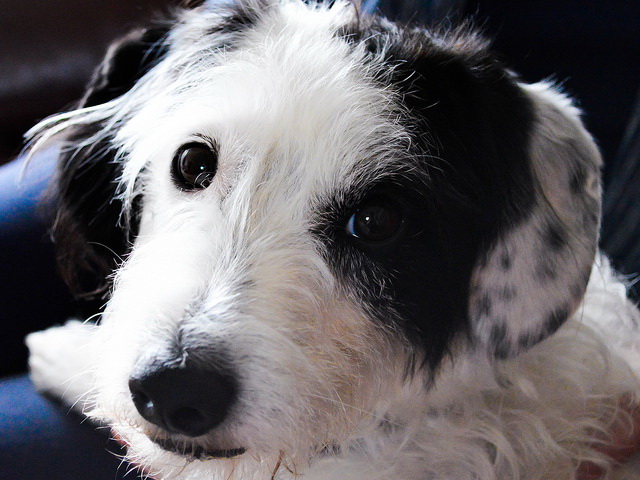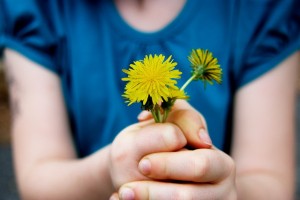by Pam Green
As your dog gets older , she (he) will need more consideration from you for her comfort and safety. A few indulgences and privileges can be granted to add to her comfort and pleasure. Your affection is more important than ever.Surely she has earned it !
Since dogs, unlike people, don’t look back at their past and compare it to the present, they don’t feel the regrets that we do over diminishing capabilities. They don’t worry about wrinkles, grey hair, and being “over the hill”. Bouvs, being laid-back and (not to put too fine a point on it) somewhat lazy, are especially able to adjust to a geriatric lifestyle that contains plenty of comfort and plenty of love. Their geriatric years can be very rewarding for them and for you.
Age usually brings some degree of stiffness and creakiness to even the soundest dog. Arthritis is usually present to some degree sooner or later. Damage remaining from old injuries and accumulated damage from poorly formed joints becomes more troublesome. Muscle mass decreases and muscles become weaker, especially in the rear legs.
Cold and damp are enemies to the arthritic dog, and even the non-arthritic old dog has less tolerance for chilling. I notice old dogs more likely to gravitate to the warmer parts of the house, eg hanging out near the woodstove in my home. In cold, windy, or rainy weather , your Bouv may appreciate the comfort of a dog-coat for outdoor activities. (Chelsea’s red parka really does make her look like a Giant Scotty !) A light blanket thrown over or nested about your Bouv at night will prevent chilling during sleep and reduce arthritic discomfort. (I can testify personally that my own arthritic shoulder gives much less complaint if I wear a sweatshirt to bed.) A heated bed or a bedmate to snuggle against can likewise be helpful. (Of course Chelsea has shared my bed all along, which may be part of the reason she’s still so functional.) A new bed warming option is the “SnuggleSafe” disc, which after being heated in the microwave oven will give off heat for about 8 hours ; this can also be used in the car or other non-heated areas.
High heat too is harder on the old dog, especially one with respiratory or heart problems. Avoid taking an old dog into such exposure. If you live in a hot climate, provide cooling for at least one room of your home. In dry climates an “evaporative cooler” can be very effective; in humid climates an air conditioner will be needed. Dogs with shortened noses (eg bulldogs, boxers, pugs, pekes , etc) are especially vulnerable at any age to heat and any other conditions making breathing more difficult.
Wherever you Bouv sleeps at night and lounges during the day , her bed should be well cushioned. A couple layers of eggcrate foam rubber with an appropriate covering works well and is easy to provide. Possibly several well padded resting places can be placed strategically about the house , giving your Bouv a choice and chance to move from room to room with you. A new option that offers cushioning and pleasurable cooling sensation is the “CanineCooler” bed, which is a thin-layer waterbed with foam rubber core, with the water acting as a heat sink for the dog’s body heat (unfortunately, I have found that the seams will separate and leak after about a year’s use, though the device is guarranteed for two years and the company is pretty good about replacing faulty ones). If your Bouv is privileged to use your bed , sofa, or other furniture, be sure she is still able to climb on and off safely. If necessary , build a sturdy ramp or stair-step and cover it with carpet. You may need to help your dog get up on the bed by lifting her rear end as she puts her front paws up on the bed. (My bed used to be a mattress directly on the floor, which was easy for an old dog to reach. Then my mother gave me her cast-off adjustable bed : wonderful for me, but higher off the ground, so harder for the old dogs.)
If your Bouv has trouble going up and down stairs or getting into the car or any other situation in which a weakened hind end is causing difficulty, you can pass a towel (or other band of cloth) under her belly and ribs to enable you to provide support by some upward tension. A sling made for carrying firewoood with handles on each end also works very well. More recently , custom fitted lifting slings are available to enable you to support rear end, front end, or middle section. You might also use a portable ramp (several are available commercially or you can make one yoruself) or folding steps to help her get into the car. You might ramp over your entry steps into the house, using external plywood with a rubber matting or cross-cleats. The one thing you probably will not be able to do is simply pick up and carry a 70 to 90 pound Bouv unless you are extremely strong. Carrying such a large dog requires two people and some kind of stretcher, eg a piece of plywood 2′ x 3′ to 3′ x 4′ preferably with handles. A small dog can be carried by one person of normal strength, either nestled in one’s arms or on a firm support or inside a crate.
Really old dogs can eventually become so weak in the rear end that they have difficulty rising from a lying down position into a standing one. Some dogs become very disheartened or even anxous over this disability. Others accept it calmly and rely on you for help, often getting your attention with a special muffled sounding bark (three different dogs of mine have used almost identical “help me” whuffles). The towel or other band passed under the rear of the dog’s rib cage is probably your best bet ; I usually insert the band just behind the dog’s elbows and then work it backwards a bit to support the rib cage. A “log carrier” designed to tote a few pieces of wood for the fireplace can be ideal, as it is a canvas sling with wooden handles at both ends. Squatting down and grasping the dog’s “sit bones” and raising them can also work well. However you supply lift, be sure that you are using your leg muscles not your back to supply the needed strength so that you do not injure yourself while assisting your dog.
Once up the dog may or may not need help (support) in walking : many are able to walk fairly well but are more vulnerable to tripping and falling.For any dog who has an increased vulnerability to falling or who is subject to seizures, you will have to evaluate your home environment and fence off access to areas which could be dangerous , eg the stairs, the hot wood-stove or coal-stove, ponds or pools. (For example, I have an “X-pen” surrounding my wood-stove during the winter.) If there is a risk of the dog going outdoors , tripping or falling and getting stranded, then in hot or cold or wet weather you may need to confine the dog indoors when you are away from home for more than short periods.
Slippery floors are dangerous for the old dog (as well as for puppies). If you see your Bouv either slipping or being very careful as she walks across your linoleum, bare wood, or tile floors, make safety paths for her with lengths of carpet runner (cheap carpet with a rubber backing) or rubber matting. Likewise icy winter sidewalks can be dangerous : avoid them if you can ; neoprene booties might help. (I don’t have any personal experience with snow & ice dog problems, because I live in the central valley of California.)
Over-long toe-nails place extra strain on the dog’s feet, which are already likely to be somewhat broken down, and compromises the dog’s ability to walk on slippery and semi-slippery surfaces. Since reduced activity means less natural wear-down of the toe-nails, you must check regularly and often to clip or grind away the excess. At the same time , notice if there is abrasion on the upper surface of the toes or any foot or if there is toenail evidence that the foot is being dragged; either may indicate some decrease in consious proprioception due to impaired nerve functioning or spinal cord functioning.
If your dog is totally unable to walk, as can happen temporarily from illness or injury, you may need to call upon a house-mate or a friend to help you carry the dog on a stretcher. (If you live alone, as I do, you need to figure out your “ohone-a-friend list ahead of actual need.) A blanket or beach towel grasped at the corners can be used as a stretcher, though fabric stretched over a frame or simply a piece of plywood strong enough for the dog’s weight are alternatives that may provide better support and be easier to grasp. Some report using a “car creeper” , that wheeled low platform that auto mechanics use to slide themselves under a vehicle, as a stretcher and as an easy way to move a non-ambulatory dog accross any smooth surface without needing to lift. Indeed , if you were able to place strong boards from your open doorway to the open door of a vehicle, this might enable you to load a dog for transport; or likewise via a ramp down from house door to ground and a ramp up from ground into vehicle. For dogs with long term disability to walk, such as dogs paralyzed in the rear legs, there are special “wheelchair carts” to support the paralyzed portion of the body. To use these, you would need to be able to lift the dog into and out of the apparatus several times a day. Some paralyzed dogs appear to enjoy a decent quality of life through the use of such a device.
Regular mild exercise is essential for all senior dogs. For arthritic dogs, as for arthritic people, the rule is “use it or lose it.” Disuse leads to loss of bone strength, muscle strength , and joint mobility : bad for any dog but worse for thse with arthritis. Moderate length slow paced walks in morning and evening should be feasible for most. Swimming , during warm weather (or in a therapy pool or tank), can be especially beneficial in moderate amounts. What is “moderate” will depend on your dog’s attitude and your vet’s assessment of her health. If your dog is too stiff to be willing to take exercise, or if she sometimes has bad days, ie with evidence of pain, ask your vet about using a buffered aspirin to ease her back into activity. (UPDATE note : today we have Rimadyl which can provide almost magical relief, but needs to be used with vigilance for liver function. More recently a new drug DeraMaxx works better for some dogs. Finally Metacam works better for some dogs and , being a liquid, is easily adjusted in dose. )
In recent years, more and more canine physical therapy clinics have become available and more vets are learning physical therapy or making alliances with those trained to do it on hairless primates . Physical therapy modes include gentlerange of motion joint exercises, theraputic massage, applications of heat or cold, supported standing on a physiotherapy ball, balancing exercises on a tiltboard, and swimming and underwater treadmill exercise. Physical therapy can be helful to dogs recovering for injuries or surgery and can help restore mobility to an old dog.
Accupuncture sometimes can be wonderfully helpful for arthritic old dogs, as well as helpful for a range of illnesses. Chiropractic can be helpful for some. More and more vets are offering one or both of these treatment modes, as well as herbal medicines and other “complementary and alternative” and “holistic” options.
Less efficient kidney function requires greater water intake and consequently more frequent urination. Thus a dog-door is especially needed, but watch to see if your dog needs to have the hole cut larger (higher and/or deeper) for easier passage and be sure the footing on both sides is secure. Old dogs who have difficulty lifting or bending their hind legs are likely to need to have the dog door cut deeper so the lower end of the opening is only a few inches above the ground. (But see remarks above about dogs who might fall and get stranded outdoors; better to come home to a puddle or a pile indoors than a heat-stroked or hypothermic or dead dog outdoors.)
Spayed bitches may develop mild urinary incontinence (similar to that affecting post-menopausal women), especially at night or when napping, which your vet can remedy with replacement hormones (DES or Premarin) or with a non-hormonal drug called PPA. For more serious incontinence, various diaper garments are available for male and female dogs. A waterproof mattress cover or an incontinence bedcover (you’ll find them next to the adult diaper pants in the pharmacy) between the dog and the dog bed or between the dog and your own bed can save a lot of aggravation.
Gradual loss of kidney function occurs over the course of many months or years as the dog ages. In the early stages this does not pose a problem as the kidneys start out with a great deal of excess capacity. At some point, the decreased function will be detectable in blood chemistry tests and urine chemistry tests. Prescription diets can help to slow the process. As the loss continues, eventually the kidneys get to the stage where the dog can no longer compensate by drinking more water.
Deterioration of heart function is another problem common in old age. Weakness or excercise intolorance can be signs of heart problems, especially when combined with any blue tinge to the color of the gums or tongue (which should be a healthy pink). Your vet may be able to hear or feel an abnormal rhythm. An EKG , cardiac ultrasound, and other diagnostic tools will be used to make the actual diagnosis. For many conditions, there are drugs that can greatly improve function and quality of life. You may need to see a veterinary cardiologist.
Obesity, bad enough at any age, is more dangerous for the old dog, putting an added burden on age-impaired joints, muscles, heart, lungs, etc. (Excessive thinness is also not good, but is less likely in our usually gluttonous breed.) Frequently feel her hips and ribs to see if she is gaining or losing; or drop by the vet’s to use the walk-on scale from time to time. Lessened activity requires lessened caloric intake. Feed a high quality , easily digestible diet; but feed less of it. Return to twice a day feeding if your dog has problems with digestion and absorption of food or simply needs to eat more than she wants to at one meal. Blood & urine tests for kidney function will let you know when and if you need to decrease protein content. Other blood tests can detect inadequacies of digestive enzymes which can be supplemented orally. Special prescription diets are available through your vetereinarian for a wide variety of medical conditions. For those who prefer home cooking, consult a veterinary nutritionist to work with your vet to ensure a diet that is correct for your dog’s individual health conditions.
More frequent checkups and tests at the vet’s will allow early detection of deteriorating or endangered body functions. Usually early detection enables you to slow the deterioration and add comfortable time to your dog’s life. Try to learn from your dog’s breeder what ailments her parents , grandparents, and other relatives experienced in old age; and pass this information to your vet. (Eg Chelsea’s dam developed glaucoma, which can be heritable; so I am on guard for symptoms.) The main causes of death for older dogs are heart disease, kidney disease, and cancer. (These are the same “big three” major causes of death for older humans; for older cats, it is kidney disease and cancer as the primary causes.) For all of these early detection can lead to improved quality and quantity of life, and for some cancers can lead to a complete cure. (Note: the field of veterinary cancer treatment is advancing so rapidly that it is impossible to keep up. More and more cancers respond well to treatment. Don’t panic and do consult a board certified veterinary oncologist (in private practice or better yet at a Vet School teaching hospital) for the current treatments. )
Regular grooming is important for healthy and comfortable skin. The coat of an old dog who lies around a lot will tend to matt more quickly. Adopt a practical coat style, less luxuriant than that fashionable for the breed ring, for easier grooming. While grooming , carefully look and feel all over your dog’s body for anything unusual that might be abnormal such as persistent lumps or sores, which should be promptly examined by your vet . Any lump is cancer until proven otherwise , ie by biopsy (often Fine Needle Aspiration is all that is needed; but some types of lump require excisional biopsy) ; but most lumps will turn out to be harmless. Do not panic, but do not unduly delay having the vet check it out. I usually snip the hair away to expose such suspicious lumps so they will be easy to find again next day at the vet’s. You may want to make a set of drawings showing locations of all the lumps and bumps as you find them and as your vet checks them out, so that you can distinguish any that are new. (Drawings are especially helpful when several dogs are involved.)
Gentle massage by you can give your dog pleasure, relief from stiffness, stimulation for blood circulation, and — most of all — an expression of your affection.
Mental exercise and enjoyment are no less important than physical exercise. A few simple non-strenuous tasks or tricks, a ride in the car ( a great joy to most dogs) , spectatorship at a training event or trial or human sporting event , a social event or picnic in the park can add a welcome variety to your old Bouv’s life. Of course if you can sometimes arrange a mild version of some familiar work or game that your Bouv really enjoys , so much the better. (Eg I occasionally let Chelsea herd sheep for a few minutes under circumstances where I know the sheep will be cooperative. During tracking season, I’ll occasionally lay her a short track with few turns and an easy article and I’ll let her run it off leash.) Or teach a new game such as find-the-hidden-toy (or hidden food treat) or find-the-hidden-person. Anything that excercises the mind.
Finally, make special time for caresses , cuddles , and sweet words. Let your aging Bouv know daily how much you love and cherish her. There is nothing sweeter or more comforting than the affection of an old friend.
- BOOKS
- “Canine Rehabilitation & Physical Therapy” by Millis, Levine, & Taylor (published 2004), written for veterinarians and physical therapists.
- Book “Complete Care for Your Aging Dog” by Amy Shojai (published 2003, full of useful material; highly recommended).
- Book “Active Years for Your Aging Dog” by Bernard Hershhorn DVM (published 1978, so does not include more recent veterinary developments.)
- Book “Old Dogs, Old Friends” by Bonnie Wilcox DVM and Chris Walkowicz (published 1991 ; good book about living with older dogs, ie lifestyle issues rather than medical ones.)
- Book “Preparing for the Loss of Your Pet”, by Dr Myrna Milani DVM (book helping you to think about the unthinkable long before a crisis occurs ; also about preparations which may help you avoid or postpone loss.)
Image: flickr.com/photos/cathedraljack/14206861858








